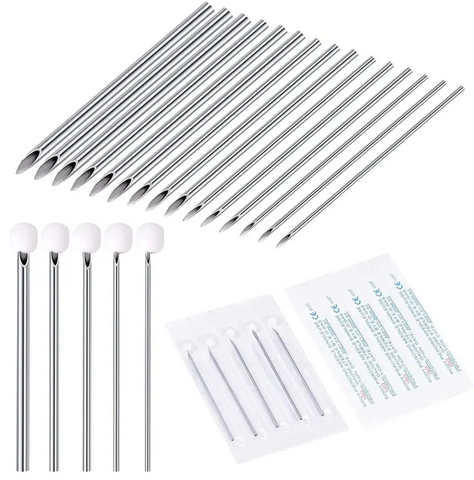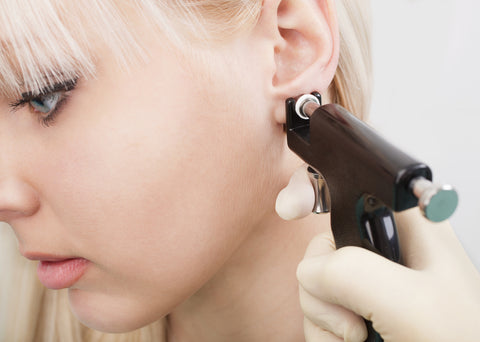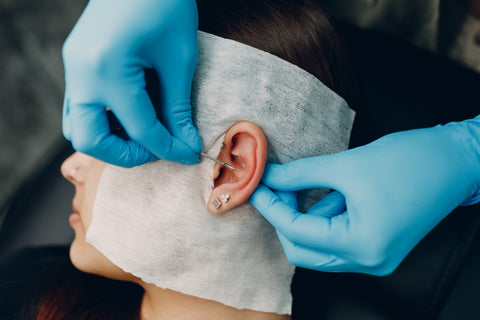Piercing Gun vs. Needle Piercing
Whether you're considering your first earring piercing or adding to your collection of ear adornments, choosing the right piercing method is crucial for ensuring a safe, comfortable experience with optimal results. In the world of ear piercings, two primary techniques stand out: piercing guns and piercing needles.In this comprehensive guide, we'll delve into the key differences between these two piercing methods, shedding light on the advantages of needle piercing and why reputable piercing studios like Lark & Berry exclusively rely on this technique for all ear piercings.
What is a Piercing Needle?

Piercing needles (or hollow needles) are the traditional tool used for body piercing. They are hollow, sharpened needles made of surgical-grade stainless steel or niobium. The needle is inserted through the area to be pierced, followed by the desired jewellery being pushed through the hollow needle once it is properly positioned.
Piercing needles allow for precision placement and come in different gauges and configurations for different piercings. They require manually applying pressure to pierce. While they create a larger initial hole than piercing guns, many piercers prefer needles as they believe they cause less tissue trauma and tearing. Proper sterilisation of piercing needles before use is crucial. For most piercings, single-use hollow needles are considered best practice to prevent cross-contamination between piercings or clients.
“At Lark & Berry, safety is our top priority. That's why we exclusively use needles for all our piercings,” remarked Svet, Lark & Berry lead stylist. “Needles offer precision, cleanliness, and reduced trauma compared to piercing guns, ensuring a safer and more comfortable experience for our clients."
What is a Piercing Gun?

Ear piercing guns are tools designed to quickly pierce soft areas like the ear lobe using force and a stud earring. The gun is loaded with a stud earring, then pressed against the area to be pierced. When the gun is triggered, a sharp post on the stud shoots through the tissue to create the piercing hole.
Piercing guns pierce by blunt force rather than a hollow needle. They are faster and perceived as less painful than needles for basic earlobe piercings. However, piercing guns cannot be properly sterilised, create traumatic sheared piercing channels, and are ill-suited for most cartilage piercings. The studs are difficult to insert at precise angles.
Many professional piercers do not recommend piercing guns, especially for areas other than the earlobe, due to higher risks of complications like sheared piercings, uneven healing, potential cartilage damage, and exposure to improperly sterilised equipment.
Piercing Gun Risks
While piercing guns are sometimes still used out of convenience, they carry significant risks and downsides compared to professional piercing needles. From the potential for improper sterilisation and disease transmission, to increased trauma and healing complications, there are numerous safety concerns with these piercing instruments such as:
Potential for Improper Sterilisation
One major drawback of piercing guns is the inability to properly sterilise them between uses. The gun's internal mechanisms cannot undergo the same rigorous sterilisation process as hollow piercing needles. This raises risks of cross-contamination and transmission of bloodborne pathogens like hepatitis B, hepatitis C, or HIV between clients if proper disposable procedures are not strictly followed. Piercing needles are single-use, drastically reducing these contamination risks.
Increased Tissue Trauma
Piercing guns essentially punch a hole through the tissue using blunt force. In contrast, hollow piercing needles separate the tissue in a more gentle way. This blunt force can cause excessive bleeding, shearing of the piercing channel, and more tissue trauma than a hollow needle. This significant tissue damage can potentially lead to poorer healing and more unsightly scarring.
Suboptimal for Cartilage Piercings
Most reputable professional piercers do not recommend using piercing guns on any part of the ear's cartilage. The sharpened earring posts can shatter rigid cartilage upon entry, causing severe pain and permanent disfigurement. The trauma and shearing forces are also much higher risks for forming excessive scar tissue around the piercing. Hollow needles are the appropriate tool for all cartilage piercings.
Struggles with Angles and Positioning
The design of piercing guns makes it very difficult to pierce at precise angles other than straight through an earlobe. Any sort of angle is problematic and raises chances of the piercing being off centre or injuring surrounding tissue. Freehand placement with a hollow piercing needle allows for much greater control and positioning flexibility.
Benefits of Piercing Needles

While piercing guns have persisted out of convenience, hollow piercing needles offer numerous advantages that make them the preferred method among professional piercers.
"The benefits of needle piercing are undeniable,” said Svet, lead piercer at Lark & Berry. “Our clients often express surprise at how easy and quick the procedure is, even if it's their first time. With needles, we minimise discomfort and promote faster healing, providing our clients with a positive piercing experience they'll remember."
From improved sterility and safety to greater precision and placement control, hollow needles are simply the superior instrument for body piercing. Let's explore some of the key benefits of needle piercing over piercing guns:
Sterility and Safety
One of the biggest advantages of using a hollow piercing needle is that it can be properly sterilised before use and is disposable after a single piercing. This drastically reduces any risk of cross-contamination between clients. Piercing needles are put through an autoclave or chemically sterilised to kill any potential viruses or bacteria. Their single-use nature eliminates the need to attempt re-sterilising the same equipment. Proper sterilisation helps prevent transmission of bloodborne pathogens like hepatitis or HIV.
Precision and Placement
Skilled piercers can angle and position a hollow piercing needle with great precision during the freehand technique. This allows for optimal entry and exit point placement based on the individual's anatomy. Needles come in a variety of gauges and configurations suited for different piercing locations. With piercing guns, angles are limited and there is much less control over precise positioning of the initial hole.
Reduced Trauma and Scarring
Hollow piercing needles separate the tissue in a more gentle way compared to the blunt force trauma caused by a piercing gun's post. This minimises bleeding, swelling, tearing of the tissue and scarring. The piercing channel is smoothly created rather than sheared and punched through. When properly performed, needle piercing can result in better healing and reduced risk of issues like excessive scarring.
Versatility for Different Placements
While piercing guns are essentially limited to just soft areas like earlobes, hollow piercing needles allow piercers to safely pierce nearly any area of the body - including earlobes, nostrils, navels, and cartilage. There are few limitations in terms of viable placements when using proper piercing needles and having an experienced piercer. Guns are ineffective for most piercings beyond basic earlobe piercings.
Piercing Guns vs. Piercing Needles: Which Should You Choose?
Pain Level
Piercing guns use a sharp stud to punch through the ear in one swift motion. This quick puncture can cause intense, crackling pain in that moment. Needle piercings tend to be more of a pinching sensation as the hollow needle is gently pushed through the tissue. For most people, needles feel like less immediate pain overall.
Safety Considerations
Piercing guns cannot be properly sterilised since they are reused on multiple clients. This raises the risk of spreading blood-borne pathogens. Needles are single-use, going straight from an autoclaved sealed pouch into your fresh piercing. Needles allow for a precise angle and entrance/exit point placement as well. Overall, hollow needles are considered much safer.
Healing Time
The blunt force of a piercing gun can cause significant trauma and swelling to the pierced area. More trauma typically means a longer healing time of 6-8 weeks or even months. Needle piercings create a precise wound that can heal relatively quickly, often within 4-6 weeks if properly cared for. Overall, needles provide a faster healing process.
Get a Professional Ear Piercing at Lark & Berry

At Lark & Berry, we prioritise your safety, comfort, and satisfaction above all else when it comes to piercings. Our experienced piercers exclusively use hollow piercing needles to pierce ears and follow strict sterilisation protocols to ensure a precise, hygienic experience.
Whether you're getting your first lobe piercing or exploring a look featuring multiple piercings, you can trust our team to guide you every step of the way. We'll carefully assess your anatomy, answer any questions, and help you choose the perfect ear piercing jewellery to complement your new look.
Say goodbye to outdated piercing guns and their associated risks - at Lark & Berry, we're committed to bringing you the gold standard in ear piercing through our professional needle techniques. Book your appointment today and get ready to confidently rock your newest accessory!



